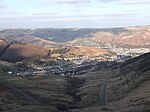St John's Church, Dowlais
Churches completed in 1894Former churches in WalesGrade II listed churches in Merthyr Tydfil County BoroughRebuilt church buildings in WalesReligious organizations disestablished in 1997 ... and 3 more
Religious organizations established in 1827United Kingdom church stubsWelsh building and structure stubs

St John's Church is a defunct Grade II listed church in the village of Dowlais, near Merthyr Tydfil in Wales. The church was built in 1827 for local ironworks manager Sir John Josiah Guest, at a cost of £3000. It was gradually completely rebuilt later in the century, in a Gothic style, finishing with the main nave and aisle in 1893/4. Sir John (d. 1852) was buried in an iron coffin in the chancel under a red granite slab.The church finally closed in 1997 and, in early 2015, was put up for sale with an asking price of £50,000. It was subsequently earmarked for £400,000 of Welsh Government grants to support its repair and redevelopment.
Excerpt from the Wikipedia article St John's Church, Dowlais (License: CC BY-SA 3.0, Authors, Images).St John's Church, Dowlais
Upper Union Street,
Geographical coordinates (GPS) Address Nearby Places Show on map
Geographical coordinates (GPS)
| Latitude | Longitude |
|---|---|
| N 51.7614991 ° | E -3.3543569 ° |
Address
Upper Union Street
Upper Union Street
CF48 2AJ , Dowlais Top
Wales, United Kingdom
Open on Google Maps





